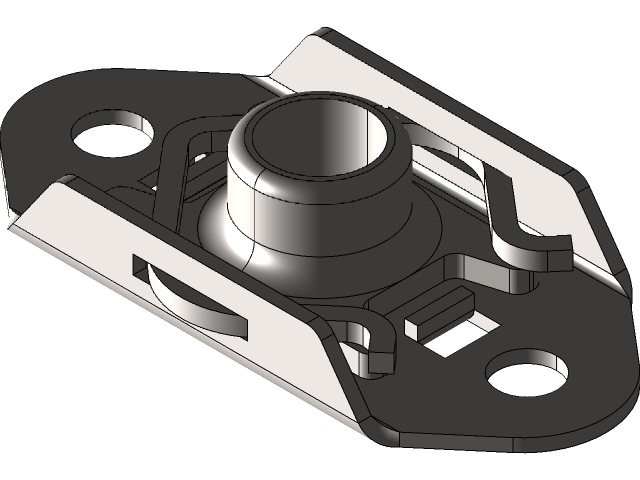
Working on projects at Belcan increased my ability to apply engineering principles to real-world challenges, manage tasks effectively, and contribute to the success of complex projects. My time at Belcan Engineering played a key part in shaping my approach to mechanical design and engineering, providing me with the skills and experience needed to excel in future roles.
Summary
During the summer of 2022, I had the opportunity to work as a Mechanical Design Engineer Intern at Belcan Engineering in Peoria, Illinois. With a focus on innovation and precision, Belcan supports complex projects that require cutting-edge technology and expertise. The team I was part of was deeply involved in mechanical analysis and engine manufacturing. We were responsible for ensuring that all projects met stringent requirements for producibility and manufacturability while adhering to tight deadlines.
This role allowed me to dive into real-world engineering challenges, applying my computer-aided design (CAD) and mechanical analysis skills to a significant project involving upgrading B-52 bombers. Working closely with a team dedicated to providing digital engineering solutions for aerospace, defense, and government services, I gained valuable experience that shaped my understanding of engineering in a high-stakes environment.



Situation
Belcan Engineering is a leader in the engineering services industry and is known for providing top-tier digital solutions. During my internship, I was part of a team working on a crucial project for Rolls-Royce, focused on retooling and upgrading B-52 bombers. The B-52, a strategic bomber that first entered service in the 1950s, is being modernized to remain operational through the 2050s, potentially making it a century-old aircraft still in active service.
The project involved replacing the bomber’s aging engines with new, more efficient ones as part of the U.S. Air Force's B-52 Commercial Engine Replacement Program (CERP). This upgrade also included converting all design specifications from metric to U.S. customary units to ensure compatibility with U.S. manufacturing processes. The work was even more complex because much of the technical documentation was in German, requiring careful translation and adaptation.

Task
My primary responsibility was redesigning tools and components using computer-aided design (CAD) to meet the new specifications required for the B-52 bomber upgrades. This involved translating German-language directions, converting measurements from metric to U.S. customary units, and ensuring the redesigned components would perform effectively in their new configurations. The upgraded engines would allow the B-52 to fly farther and use less fuel, which required precise engineering adjustments to integrate the latest technology into the existing airframe.
I assisted the engineering team by performing mechanical analysis, hand calculations, and durability assessments for various components. I composed engineering documentation and maintained clear and consistent communication with internal team management. My role supported the movement of design evaluations from request to completion, ensuring that all tasks were prioritized and managed effectively.


Action
To address the demands of this role, I first familiarized myself with the project requirements and engineering processes used at Belcan. To tackle the project, I then made sure I fully understood the goals and engineering methods required for the B-52 upgrades.
Translation of the German documentation was a critical first step, as it provided the necessary guidelines for the retooling process. I then applied my CAD skills to redesign the tools and components, ensuring that they met the rigorous standards for durability and performance required in aircraft repair and maintenance. This included adapting the designs to accommodate the new Rolls-Royce engines, expected to power the B-52 through its remaining decades of service.
I documented my findings, ensuring all engineering documentation was accurate, organized, and up-to-date. I also took the initiative to improve the organization of existing records, making it easier for the team to access and utilize critical information.
My work involved close collaboration with my teammates, as we regularly discussed our progress and challenges. I also kept the team updated through general reports, ensuring that we stayed on track to meet the project deadlines.


Result
The work I completed during my internship was crucial in advancing the B-52 bomber upgrade project. The redesigned tools and components met the necessary standards for conversion to U.S. customary units and were optimized for performance and durability. My ability to translate and apply complex engineering instructions from German into practical, effective designs contributed significantly to the project's success.
Integrating the new Rolls-Royce engines into the B-52 airframe was a key milestone in extending the operational life of these iconic bombers. This internship enhanced my technical skills in CAD and mechanical design and underscored the importance of clear communication and teamwork in delivering high-quality engineering solutions.

Technical and Professional Skills Utilized
- Computer-Aided Design (CAD): Applied CAD software to redesign tools and components for the B-52 bomber upgrades, ensuring they met the new specifications and performance standards.
- Mechanical Analysis: Conducted mechanical analysis to evaluate the performance and durability of redesigned components in alignment with project requirements.
- Engineering Documentation Translation: Translated technical documents from German to English, facilitating accurate and effective retooling and design conversion.
- Measurement Conversion: Converted engineering specifications from metric to U.S. customary units, ensuring compatibility with U.S. manufacturing processes.
- Component Durability Assessment: Assessed the durability of retooled components to ensure they met the stringent requirements of aircraft repair and maintenance.
- Project Management: Managed the progression of design tasks, keeping track of deadlines and ensuring timely delivery of project milestones.
- Technical Reporting: Provided general progress reports to team management, summarizing the status of design tasks and any challenges encountered.
- Collaboration and Communication: Worked closely with team members, participating in meetings and discussions to ensure alignment and smooth project execution.
- Problem-Solving: Addressed complex engineering challenges, such as translating German instructions and adapting designs to meet new specifications, using a methodical and analytical approach.